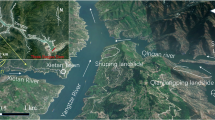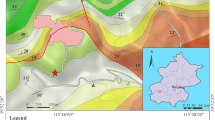Abstract
On June 5, 2009, a catastrophic rockslide-debris flow occurred at the crest of the Jiweishan Mountain in Wulong, Chongqing, China. Approximately five million cubic meters of limestone blocks slid along a weak interlayer of bituminous and carbonaceous shale. The source mass descended from the upper part of the slope rapidly, crossing a 200-m wide and 50-m deep creek in front of it. Blocked by the opposite steep creek wall, the sliding mass changed its direction and traveled a further 2.2 km along the creek in debris-flow mode, finally forming a large accumulation zone with an average depth of 30 m. This is one of the most catastrophic rockslide events in recent years in China. It buried 12 houses and the entrance of an iron mining tunnel where some 27 miners were working inside. Ten people died, 64 missing, and eight wounded. Immediately after this disaster happened, the government organized an expert team to assist the rescue work. As one of the geological experts, the author did a lot of field investigations and collected first-hand information. Multi-methods including the remote sensing, 3D laser scanning, geophysical exploration, and numerical modeling were used for analyzing the characteristics and the triggering mechanism of the Wulong rockslide. The preliminary investigation results reveal that this rockslide with poor geological conditions was mainly induced by the gravitation and the karst effect and also affected by the previous mining activities. The research in this paper is meaningful and useful for further research on such kind of rockslides that are geologically similar to the Wulong rockslide.


























Similar content being viewed by others
Reference
Adushkin VV (2006) Mobility of rock avalanches triggered by underground nuclear explosions$ Landslides from Massive Rock Slope Failure. Springer, The Netherlands, pp 267–284
Bell FG (2007) Engineering geology, 2nd edn. Butterworth-Heinemann, Jordan Hill an imprint of Elsevier Linacre House
Buss E, Heim A (1881) Der Bergsturz von Elm. Worster, Zurich, p 133
Cruden DM, Varnes DJ (1996) Landslides types and processes. In: Turner AK, Schuster RL (eds) Landslides Investigation and Mitigation: Transportation Research Board. US National Research Council, Washington, DC, pp 36–75 Special Report 247
Dade WB, Huppert HE (1998) Long-runout rock falls. Geology 26(9):803–806
Dunning SA, Rosser NJ, Petley DN, Massey CR (2006) Formation and failure of the Tsatichhu landslide dam, Bhutan. Landslides 3:107–113
Evans SG (2006) Single-event landslides resulting from massive rock slope failure: characterizing their frequency and impact on society. In: Evans SG, Mugnozza GS, Strom AL, Hermanns RL (eds) Landslides from massive rock slope failure. Springer, Dordrecht, pp 53–73
Evans SG, Brooks GR (1991) Prehistoric debris avalanches from Mount Cayley volcano, British Columbia. Can J Earth Science 28:1365–1374
Evans SG, Oldrich H, Clague JJ (2001) Dynamics of the 1984 rock avalanche and associated distal debris flow on Mount Cayley, British Columbia, Canada; implication for landslide hazard assessment on dissected volcanoes. Eng Geol 61:29–51
Geertsema M, Hungr O, Schwab JW, Evans SG (2006) A large rockslide-debris avalanche in Cohesive soil at Pink Mountain, northeastern British Columbia, Canada. Eng Geol 83:64–75
Guthrie RH, Evans SG, Catane SG, Zarco MAH, Saturay RM Jr (2009) The 17 February 2006 rockslide-debris avalanche at Guinsaugon Philippines: a synthesis. Bull Eng Geol Environ 68:201–213
Hoek E, Brown ET (1997) Practical estimates of rock mass strength. International Journal Rock Mechanics Mining Science 34:1165–1186
Hungr O (1995) A model for the runout analysis of rapid flow slides, debris flows, and avalanches. Can Geotech J 32:610–623
Hungr O, Evens SG, Bovis MJ, Hutchinson JN (2001) A review of the classification of landslides of the flow type. Environ Eng Geosci 7(3):221–238
Hungr O (2004) Landslide hazard assessment—goals and challenges. Innovation. . Magazine of the B.C. Association of Professional Engineers and Geoscientists 8:12–15
Hungr O, Evans SG (1996) Rock avalanche runout prediction using a dynamic model. In: Senneset K (ed) Landslides, Proceedings of the 7th International Symposium on landslides, Trondheim, Norway. vol. 1. Balkema, Rotterdam, pp 233–238
Hungr O, Evans SG (2004) Entrainment of debris in rock avalanches: an analysis of a long run-out mechanism. GSA Bull 116:1240–1252 doi:10.1130/B25362.1
Hutchinson JN, Bhandari RK (1971) Undrained loading, a fundamental mechanism of mudflow and other mass movements. Géotechnique 21:353–358
Jarman D (2006) Large rock slope failures in the Highlands of Scoland: Characterisation, causes and spatial distribution. Eng Geol 83:161–182
Legros F (2002) The mobility of long-runout landslides. Eng Geol 63:301–331
Rose ND, Hungr O (2007) Forecasting potential rock slope failure in open pit mines using the inverse-velocity method. Int J Rock Mech Min Sci 44:308–320
Sassa K (1985) The mechanism of debris flows: San Francisco, California, Proceedings XI International Conference on Soil Mechanics and Foundation Engineering 1: 1173–1176
Sassa, K (1988) Geotechnical model for the motion of landslides (Special lecture), Landslides, in Bonnard, C., ed.: Proceedings, 5th International Symposium on Landslides, 1: 37–56.
Tang CA (1997) Numerical simulation of progressive rock failure and associated seismicity. Int J Rock Mech Min Sci 34:249–261
Voight B, Sousa J (1994) Lessons from Ontake-san: a comparative analysis of debris avalanche dynamics. Eng Geol 38:261–297
Zavodni ZM (2000) Time-dependent movements of open-pit slopes. In: Hustrulid A, Carter MK, Van Zyl DJA (eds) Slope stability in surface mining. Society for Mining, Metallurgy, and Exploration, Inc., Littleton
Zhang ZY, Wang ST, Wang LS (1994) Principles of geological engineering. Geology, London, pp 338–346
Acknowledgements
This research is financially supported by the National Basic Research Program “973” Project of the Ministry of Science and Technology of the People’s Republic of China (2008CB425801) as well as the Creative Team Program of the Ministry of Education in China. The authors acknowledge the contributions from every member of the expert team from the Ministry of Land and Resources P.R.C. and the State Administration of Work Safety. We acknowledge all the geologists from local geological institutes who assisted in the field investigation. We appreciate the great supports in field work and data collecting from the leaders of Chongqing government, the Ministry of Land and Resources P.R.C, the China Geological Survey, and other related departments. Last but not least, we would like to give our special thanks to Min Wang, Fengjun Guan and Yuan Liu for their great supports to the expert team.
Author information
Authors and Affiliations
Corresponding author
Rights and permissions
About this article
Cite this article
Xu, Q., Fan, X., Huang, R. et al. A catastrophic rockslide-debris flow in Wulong, Chongqing, China in 2009: background, characterization, and causes. Landslides 7, 75–87 (2010). https://doi.org/10.1007/s10346-009-0179-y
Received:
Accepted:
Published:
Issue Date:
DOI: https://doi.org/10.1007/s10346-009-0179-y




